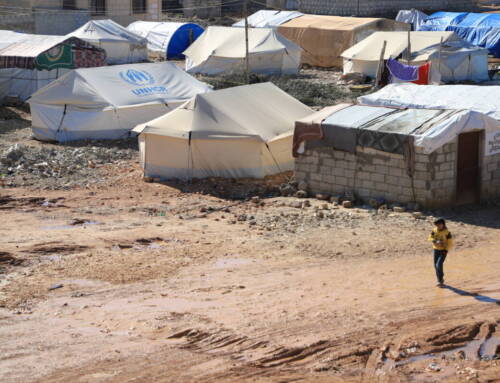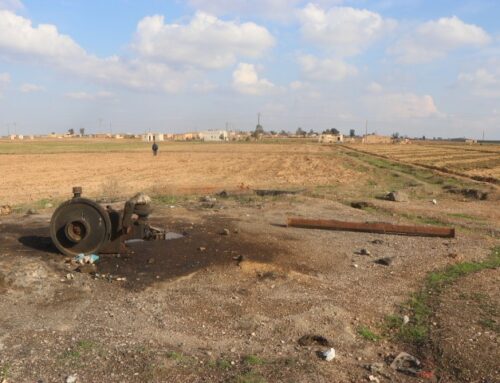Syrian pound meets ‘a bout of extreme weakness’ after Moscow announces withdrawal
In March 2011, before the earliest popular protests demanding the […]
30 March 2016
In March 2011, before the earliest popular protests demanding the fall of the Assad government, one American dollar was worth 46 Syrian pounds.
Today the dollar sells for 505 Syrian pounds.
To put this in context, consider the following: A Syrian businessman who brought SP1,000,000 to his local money changer in 2011 would receive around $20,000 in return. Today that same SP1,000,000 would net less than $2,000.

Hanke served as an architect of currency reforms in emerging-market economies including Argentina, Estonia, Bulgaria and Bosnia.
“I think I’ve killed more hyperinflations than any living economist,” says Hanke, who is also an active currency trader.
Here, Hanke explains that despite a recent “bout of weakness” caused by the March 14 announcement of Russia’s withdrawal from Syria, the Syrian currency has actually followed a “steady,” rather than a chaotic, decline.
“The resilience of the government is in a way the story. If you go back to the summer of 2013 it looked like the thing was going to spin out of control. And that’s typical of these kinds of wars. Usually it spins out of control, but it didn’t here.”
Q: You have spent the past three years tracking the Syrian pound. Why?
The black-market exchange rate is really the most important price in Syria because its the only real free-market price. It’s also very pervasive because it affects everything.
In terms of the functioning of the economy, this is objective hard data. Of course the exchange rate differs from street corner to street corner. But I collect data from across the country and run it through my own mechanism, which I’ve been using for quite a long time.
Overall we find that this currency data is a very good barometer of the state of affairs—of what is actually going on.
Q: So what is actually going on?
I’ve been watching the Syrian pound since 2012. When the conflict started, the currency was pretty steady. But in the summer of 2013 things started to go badly. The annual implied inflation rate peaked at slightly over 375 percent. This was a hyperinflation scare. The situation looked like it could spin out of control.
[Ed.: Hyperinflation is a rapid or out-of-control rise in prices. The convention in the economics profession is that an inflation rate of 50 percent per month is considered hyperinflation. Current inflation rates in Syria do not reach this bar at approximately 80 percent per year—see below]But then it started coming down and really stabilized by the summer and fall of 2014 before starting a gradual climb back up.
And since then the rate has been—it’s been very stable—but it’s been around 80 percent as an annual implied inflation rate derived from changes in the black market exchange rate. In fact if you go back, it’s kind of inched up very, very gradually but I would say that since around May 2015 its been very stable at the 70 percent to 80 percent range. This of course means that if you look at the exchange rate it’s been kind of sliding up.
[Ed.: Economists calculate annual implied inflation from exchange rates. All else equal if the exchange rate does not change then inflation will be zero. An exchange rate of 80 percent indicates that the exchange rate is increasing.]If you go back to May 2015 the exchange rate was about SP3oo, whereas now it’s about SP507 to the dollar. The official rate is now SP219 but the black market is at SP507. This can vary, obviously.
Recently though we’ve seen a little jump. From March 19 it’s gone from SP477 to SP507, which is about a six percent depreciation. That’s is a little on the steep side. I mean it’s always depreciating—kind of gradually crawling down in value and that’s why the annual implied inflation rate keeps pretty elevated at 80 percent. But last week when this depreciation occurred the annual implied inflation rate got up to almost 100percent.
Q: Do you have any insight into what caused this recent depreciation?
I wrote an article about the Syrian currency when the Russians first intervened and said it would be very interesting to follow the exchange rate and the implied inflation rate to see if this Russian involvement would strengthen the pound. Well it didn’t. But when the Russians announced their so-called withdrawal, the pound did experience a bout of extreme weakness.
It appears to be a short-term, knee-jerk reaction—a sort of panic attack–and now it’s started to stabilize again. I think when Putin made his announcement about the dialing back of support it was clearly a shock—that wasn’t anticipated. If that had been anticipated in Damascus, nothing would have happened to the currency. Most people on the street were very surprised and started selling the pound very heavily. But now it’s settling down again. Probably because they realized the Russians were only dialing down and not completely leaving.
Q: In that same article you also wrote that the Syrian economy was actually “less chaotic” than the battlefield situation might imply. Do you have any insight into what the government has done to maintain some semblance of control?
The resilience of the government is, in a way, the story. If you go back to the summer of 2013, it looked like the thing was going to spin out of control. And that’s typical of these kinds of wars. Usually it spins out of control, but it didn’t here.
Q: The black market for currency exchange has really been around since the 1980’s. Do you think this experience managing black markets has played a role in the resiliency the regime has shown during the conflict?
Well, it’s probably played some role in the sense that it’s an old game. If you’ve been playing a game for a long time then you probably know how to play it.
The authorities are supplying foreign currency but they are rationing it to the privileged few who can get it. And everyone wants to unload pounds as fast as they can get them. But it’s not as bad as other places like Venezuela where the annual implied inflation rate is over 350percent.







